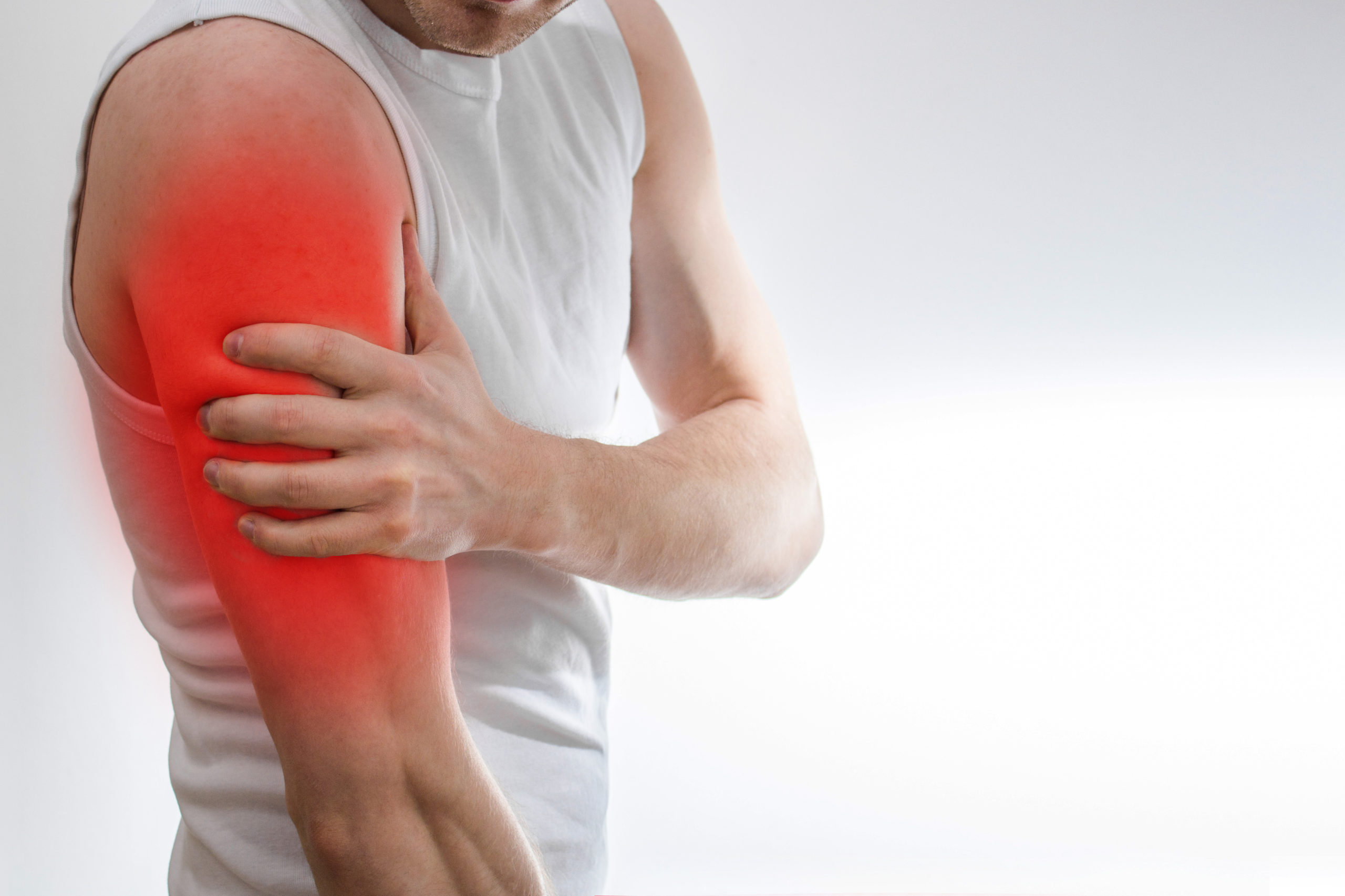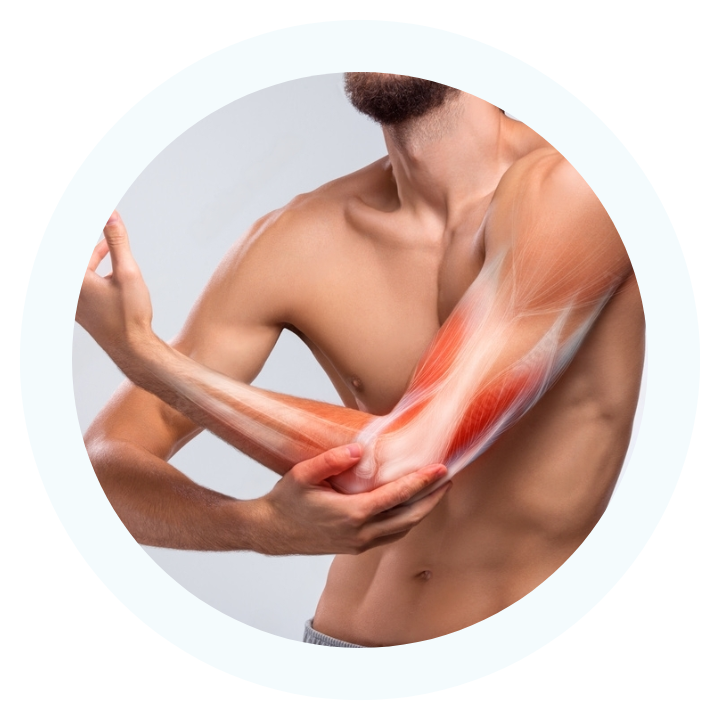Treatment for Elbow and Arm Pain
In Texas


Common Causes of Elbow and Arm Pain
- Sports Injury : Sports injuries, such as sprains, strains, and fractures, can cause significant pain in the elbow and arm. These injuries often result from overuse, impact, or improper technique during physical activities.
- Tennis Elbow (Lateral Epicondylitis) : Tennis elbow is a condition caused by repetitive stress and overuse of the forearm muscles and tendons. It leads to pain and tenderness on the outer side of the elbow.
- Golfer's Elbow (Medial Epicondylitis) : Golfer's elbow is similar to tennis elbow but affects the inner side of the elbow. It is caused by repetitive motions that strain the forearm muscles and tendons.
- Osteoarthritis : Osteoarthritis is a degenerative joint disease that causes the breakdown of cartilage in the elbow and arm joints, leading to pain, stiffness, and reduced range of motion.
- Bursitis: Bursitis is the inflammation of the bursae, small fluid-filled sacs that cushion the bones, tendons, and muscles around the elbow joint. This condition can cause pain and swelling.
- Tendonitis: Tendonitis in the elbow and arm involves inflammation of the tendons, often due to repetitive strain or sudden injury. It can lead to pain, tenderness, and restricted movement.
- Cubital Tunnel Syndrome : Cubital tunnel syndrome occurs when the ulnar nerve is compressed or irritated as it passes through the cubital tunnel in the elbow. This can cause pain, numbness, and tingling in the elbow, forearm, and fingers.
- Radial Tunnel Syndrome: Radial tunnel syndrome is caused by compression of the radial nerve, leading to pain in the forearm and elbow. This condition is often confused with tennis elbow.
- Fractures and Dislocations: Fractures and dislocations of the elbow and arm bones can cause severe pain, swelling, and inability to move the affected area. These injuries usually result from trauma or impact.
- Nerve Entrapment: Nerve entrapment occurs when nerves in the arm or elbow are compressed or pinched, leading to pain, numbness, and weakness. Common sites include the ulnar nerve and median nerve.
Diagnosing Elbow and Arm Pain
Diagnosis of elbow and arm pain involves a thorough medical history and physical examination. Imaging tests such as X-rays, MRI, or CT scans may be used to identify the underlying cause. Nerve conduction studies or electromyography (EMG) may be performed to evaluate nerve function.

Treatment Options for Elbow and Arm Pain
- Corticosteroid Injections:Corticosteroid injections deliver anti-inflammatory medication directly into the affected area, reducing inflammation and pain associated with conditions like tendonitis, bursitis, and arthritis..
- Platelet-Rich Plasma (PRP) Injection: PRP therapy involves injecting a concentration of the patient's own platelets to promote healing and reduce pain in injured or inflamed elbow and arm tissues.
- Amniotic Injections: Amniotic injections use amniotic fluid or tissue to promote healing and reduce inflammation, providing relief for elbow and arm injuries and degenerative conditions.
- Exosome Injections: Exosome injections deliver regenerative particles that can aid in the healing of damaged elbow and arm tissues, reducing pain and improving function..
- Over-the-Counter Pain Relievers: Ibuprofen, acetaminophen, and naproxen can help reduce pain and inflammation associated with elbow and arm conditions.
- Prescription Medications: Anti-inflammatory drugs, muscle relaxants, and pain relievers may be prescribed for severe pain and inflammation in the elbow and arm.
- Anti-Inflammatory Creams: Topical creams containing anti-inflammatory agents can be applied to the elbow and arm to reduce pain and swelling.
- Exercise Programs: Tailored exercises to strengthen the muscles around the elbow and arm, improve flexibility, and restore range of motion.
- Manual Therapy: Techniques such as massage, mobilization, and stretching to relieve muscle tension, improve mobility, and reduce pain in the elbow and arm.
- Acupuncture: Insertion of fine needles into specific points on the body to relieve pain and promote healing, which can be effective for preventing and treating various types of elbow and arm pain.
- Chiropractic Care: Joint adjustments and manipulations to improve alignment and reduce pain in the elbow and arm, particularly for conditions related to nerve entrapment.
- Massage Therapy: Techniques to reduce muscle tension, promote relaxation, and alleviate pain in the elbow and arm.
- Transcutaneous Electrical Nerve Stimulation (TENs) Unit: A device that uses electrical currents to stimulate nerves and reduce pain, which can be helpful for managing chronic elbow and arm pain.
- Braces and Splints: Supportive braces and splints can help stabilize the elbow and arm, reducing pain and preventing further injury.
- Ultrasound Therapy: Use of sound waves to promote tissue healing and reduce inflammation, which can help alleviate pain in the elbow and arm.
- Shockwave Therapy:A non-invasive treatment that uses shockwaves to stimulate healing and reduce pain, which can be beneficial for certain types of chronic elbow and arm pain.
Interventional Therapies
Medications
Physical Therapy
Alternative Treatments
Conclusion
Elbow and arm pain can significantly impact your daily life, but with the right approach, it can be effectively managed. Understanding the cause of your pain and working with healthcare professionals to develop a personalized treatment plan can help you find relief and improve your quality of life. If you are struggling with persistent or severe elbow and arm pain, seek medical advice to explore your options for diagnosis and treatment.
